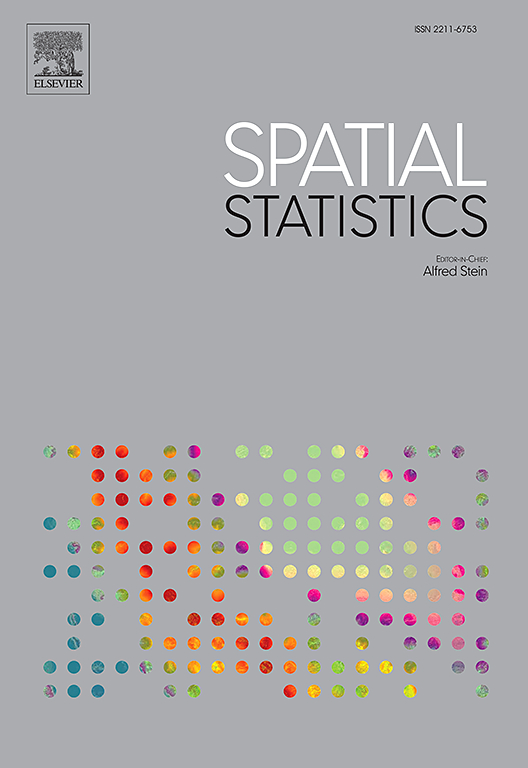基于贝叶斯最大熵的多源地理空间信息集成——以设计地面雪荷载预测为例
IF 2.5
2区 数学
Q3 GEOSCIENCES, MULTIDISCIPLINARY
引用次数: 0
摘要
由于测量过程中的各种限制和不确定性,环境数据往往是不精确的。因此,它们通常由精确和不精确信息的组合组成,分别称为硬数据和软数据。通常在实践中,软数据被描述为间隔,作为一种简单的形式,以适当地保留潜在的不精确性。贝叶斯最大熵(BME)是一种广义的空间插值方法,它同时处理硬数据和软数据,以有效地解释空间不确定性和测量不精度。本文通过仿真和可靠性目标设计地面雪荷载(RTDSL)预测的实例研究,对BME和kriging的性能进行了严格的评价。该数据集包含硬间隔和软间隔观测数据的混合,kriging通过在硬数据之外提取中点来使用软间隔数据。交叉验证结果表明,BME算法在多个误差指标上优于克里格算法。特别是对于已知精确观测值的硬数据位置,BME产生的平均误差(ME)为0.0334,平均绝对误差(MAE)为0.2309,均方根误差(RMSE)为0.2833,而克里格产生的ME为0.1960,MAE为0.2793,RMSE为0.3698。这些结果突出了BME的优越预测精度,特别是在软数据和/或非高斯硬数据的存在下。本文章由计算机程序翻译,如有差异,请以英文原文为准。
Integrating multi-source geospatial information using Bayesian maximum entropy: A case study on design ground snow load prediction
Environmental data are often imprecise due to various limitations and uncertainties in the measuring process. As a result, they often consist of a combination of both precise and imprecise information, referred to as hard and soft data, respectively. Often in practice, soft data are characterized as intervals as a simple form to properly preserve the underlying imprecision. Bayesian maximum entropy (BME) is a generalized spatial interpolation method that processes both hard and soft data simultaneously to effectively account for both spatial uncertainty and measurement imprecision. This paper presents a rigorous evaluation to compare the performances of BME and kriging through both simulation and a case study of reliability-targeted design ground snow load (RTDSL) prediction in Utah. The dataset contains a mixture of hard and soft-interval observations, and kriging uses the soft-interval data by extracting the midpoints in addition to the hard data. The cross-validated results show that BME outperforms kriging on multiple error metrics. Specifically for hard data locations where precise observations are known, BME yields a mean error (ME) of 0.0334, a mean absolute error (MAE) of 0.2309, and a root mean squared error (RMSE) of 0.2833, whereas kriging produces a ME of 0.1960, MAE of 0.2793, and RMSE of 0.3698. These results highlight the superior prediction accuracy of BME, particularly in the presence of soft data and/or non-Gaussian hard data.
求助全文
通过发布文献求助,成功后即可免费获取论文全文。
去求助
来源期刊

Spatial Statistics
GEOSCIENCES, MULTIDISCIPLINARY-MATHEMATICS, INTERDISCIPLINARY APPLICATIONS
CiteScore
4.00
自引率
21.70%
发文量
89
审稿时长
55 days
期刊介绍:
Spatial Statistics publishes articles on the theory and application of spatial and spatio-temporal statistics. It favours manuscripts that present theory generated by new applications, or in which new theory is applied to an important practical case. A purely theoretical study will only rarely be accepted. Pure case studies without methodological development are not acceptable for publication.
Spatial statistics concerns the quantitative analysis of spatial and spatio-temporal data, including their statistical dependencies, accuracy and uncertainties. Methodology for spatial statistics is typically found in probability theory, stochastic modelling and mathematical statistics as well as in information science. Spatial statistics is used in mapping, assessing spatial data quality, sampling design optimisation, modelling of dependence structures, and drawing of valid inference from a limited set of spatio-temporal data.
 求助内容:
求助内容: 应助结果提醒方式:
应助结果提醒方式:


